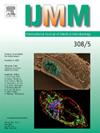blaESBL-和blaCARBA-阳性多重耐药混合菌株的鉴定
IF 3.6
3区 医学
Q1 MICROBIOLOGY
引用次数: 0
摘要
目的研究从人类宿主中分离出的blacarba阳性多药耐药calmixta菌株的鉴定,并在全物种范围内阐明其基因组决定因素。方法于2024年6 - 7月在爱尔兰戈尔韦参考实验室接收2株产碳青霉烯酶的卡利达分枝杆菌。一种分离株来自痰样本,另一种来自常规筛查直肠拭子。使用MALDI-ToF质谱进行初步鉴定,通过16S rRNA测序、数字DNA-DNA杂交和平均核苷酸鉴定分析进行基因组鉴定。根据EUCAST和CLSI指南,使用MicroScan面板进行抗菌药敏试验。采用全基因组测序、质粒复制子分型、抗生素耐药基因和毒力因子分析。比较分析包括NCBI数据库中所有额外的典型calida基因组。结果两株爱尔兰分离菌均为卡利达分枝杆菌,对青霉素类、头孢菌素类、单巴坦类和厄他培南均表现出多重耐药。在质粒载体上检测到获得基因blaKPC-3、blaxa -9和blaem -122,表明是水平获得的。两株菌株共有7种质粒复制子类型。质粒复制子和获得性抗菌素耐药基因(ARGs)在整个物种中很少被发现。基于核心基因组分析的系统发育推断确定了一个单系集群,表明一个单一的引入事件。结论黑卡巴阳性calida在人类定殖和感染中双重发生。这一发现强调了水平基因转移在该物种中推动多药耐药谱出现的潜力,强调了加强监测、诊断精度和有针对性的感染控制策略以减轻公共卫生风险的必要性。本研究报道了从不同人类宿主中分离出的blaESBL和blacarba阳性多重耐药calida混合菌。基因组分析显示,质粒携带的耐药基因blaKPC-3、blaxa -9和blaem -122同时存在。全种系统发育分析将这两个分离物归为单系群,表明这是一个单一的引入事件。本文章由计算机程序翻译,如有差异,请以英文原文为准。
Identification of blaESBL- and blaCARBA- Positive Multi-Drug Resistant Mixta calida Isolates from Distinct Human Hosts
Objective
This study aimed to investigate the identification of blaCARBA-positive multidrug-resistant Mixta calida isolates from human hosts and to elucidate their genomic determinants in a species-wide context.
Methods
Two carbapenemase-producing M. calida isolates were received by the Galway Reference Laboratory Service in Ireland between June and July 2024. One isolate originated from a sputum sample, while the other was recovered from a routine screening rectal swab. Initial identification was performed using MALDI-ToF mass spectrometry, with genomic confirmation via 16S rRNA sequencing, digital DNA-DNA hybridization, and Average Nucleotide Identity analysis. Antimicrobial susceptibility testing was conducted using a MicroScan panel, following EUCAST and CLSI guidelines. Whole-genome sequencing, plasmid replicon typing, and antibiotic-resistance-gene and virulence-factor profiling were employed. Comparative analysis included all additional canonical M. calida genomes from NCBI database.
Results
Both Irish isolates were taxonomically placed as M. calida and exhibited multidrug resistance against penicillins, cephalosporins, monobactams and ertapenem. The acquired genes blaKPC-3, blaOXA-9, and blaTEM-122 were detected on plasmid-borne contigs, indicating horizontal acquisition. Seven plasmid replicon types were shared between the two isolates. Both plasmid replicons and acquired antimicrobial-resistance-genes (ARGs) were seldomly identified across the species. Phylogenetic inference based on core genome analysis identified a monophyletic cluster, suggesting a single introductory event.
Conclusion
This study documents a dual occurrence of blaCARBA-positive M. calida in human colonisation and infection. The findings highlight the potential for horizontal-gene-transfer to drive the emergence of multidrug-resistant profiles in the species, underscoring the need for enhanced surveillance, diagnostic precision, and targeted infection control strategies to mitigate public health risks.
Impact statement
This study reports blaESBL and blaCARBA-positive multi-drug resistant Mixta calida isolates from distinct human hosts. Genomic analysis revealed the co-occurrence of plasmid-borne resistance genes blaKPC-3, blaOXA-9, and blaTEM-122. Species-wide phylogenetic analysis grouped the two isolates into a monophyletic cluster, suggesting a single introductory event.
求助全文
通过发布文献求助,成功后即可免费获取论文全文。
去求助
来源期刊
CiteScore
9.70
自引率
0.00%
发文量
18
审稿时长
45 days
期刊介绍:
Pathogen genome sequencing projects have provided a wealth of data that need to be set in context to pathogenicity and the outcome of infections. In addition, the interplay between a pathogen and its host cell has become increasingly important to understand and interfere with diseases caused by microbial pathogens. IJMM meets these needs by focussing on genome and proteome analyses, studies dealing with the molecular mechanisms of pathogenicity and the evolution of pathogenic agents, the interactions between pathogens and host cells ("cellular microbiology"), and molecular epidemiology. To help the reader keeping up with the rapidly evolving new findings in the field of medical microbiology, IJMM publishes original articles, case studies and topical, state-of-the-art mini-reviews in a well balanced fashion. All articles are strictly peer-reviewed. Important topics are reinforced by 2 special issues per year dedicated to a particular theme. Finally, at irregular intervals, current opinions on recent or future developments in medical microbiology are presented in an editorial section.

 求助内容:
求助内容: 应助结果提醒方式:
应助结果提醒方式:


